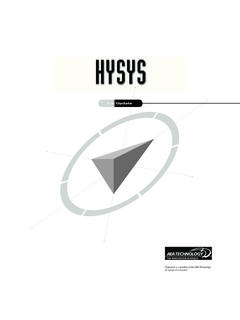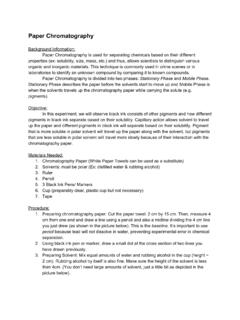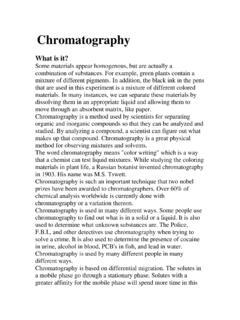Transcription of EXPERIMENT 1: Thin-Layer Chromatography and Column ...
1 Chemistry 2273a - 2009. EXPERIMENT 1: Thin-Layer Chromatography and Column Chromatography : Extraction and Separation and Plant Pigments and Common Analgesics Relevant sections in the text: WADE pages 155-163; 198-205. General Concepts Chromatography is a common and extremely useful method used to separate and analyze complex mixtures. Using this technique the course of a reaction can be followed, and the products separated and isolated. In this method, the components within the mixture are distributed between two phases : a stationary phase and a mobile phase (which moves through the stationary). Chromatography works on the principle that different compounds will have different solubilities and adsorption to the two phases between which they are to be partitioned. The material to be separated is placed onto the stationary phase and is then carried along by the mobile phase. The components of the mixture are absorbed by the stationary phase to different degrees and it is thus the various rates of migration for each component on the adsorptive materials that allows separation; the stronger the adsorption the slower the material passes through the system.
2 In this EXPERIMENT you will learn the techniques of two types of Chromatography : Column (also known as Adsorption and Partition) Chromatography and thin layer Chromatography . Column Chromatography will be used to separate the pigments present in spinach leaves, namely the green chlorophylls, orange carotenes and yellow xanthophylls. The pigments will be isolated from the leaves by solvent extraction and then separated by the two types of Chromatography . Prior to performing a bulk separation and isolation using Column Chromatography , analysis of the plant extract by Thin-Layer Chromatography (TLC) will be performed in order to find the best solvent system to be used in the large-scale separation. TLC with plant extracts produces several spots; easily identified by colour. More commonly in organic chemistry is the separation of complex mixtures of colourless components. In these cases other methods of visualization must be used. In this EXPERIMENT , you will also perform TLC analysis of common analgesic drugs to determine which components are present.
3 The organic components in these drugs are colorless and produce colourless spots on the TLC which require alternative techniques for identifying spots. Ultraviolet/visible absorption spectroscopy will be used to detect TLC spots that are otherwise colourless. During the course of Chemistry 273a and 283g you will learn other methods of visualization. 1. Chemistry 2273a - 2009. Principles of Chromatography The separation of the components of a mixture depends on the phase each component remains in and the rate at which each travels. The stationary phase does not move, while the other mobile phase travels past the fixed (stationary) phase. Due to the interaction of the various functional groups present in the solute molecules with the stationary phase, each compound travels at a different speed. The strength with which an organic compound binds to an adsorbent depends on the strength of the following types of interactions: ion-dipole, dipole- dipole, hydrogen bonding, dipole induced dipole, and van der Waals forces.
4 Different types of Chromatography use various types of stationary and mobile phases . In this EXPERIMENT , the solid phase is silica gel while the mobile phase is an organic solvent (may be a single type or a mixture of solvents). This means that the compounds to be separated must choose between being absorbed to the solid silica gel or moving along in the organic solvent. The silica gel is either packed into a Column or adhered to a sheet of glass or plastic, depending on the type of Chromatography . When a Column is used, the compound mixture is placed on top and the solvents are run down the Column separating the mixture along the way. With the silica gel on a plate, the compounds are placed close to the bottom and the mixture is separated as the solvent travels up by means of capillary action. Since silica gel is a porous form of SiO2, the surface of gel contains Si-OH and Si-O-Si functional groups. With silica gel, the dominant interactive forces between the adsorbent and the materials to be separated are of the dipole- dipole type.
5 Highly polar molecules interact fairly strongly with the polar Si O bonds of these adsorbents and will tend to stick or adsorb onto the fine particles of the adsorbent while weakly polar molecules are held less tightly. Weakly polar Figure 1. Column Chromatography set- molecules thus generally tend to move through the adsorbent up. (from Fox and Whitesell). more rapidly than the polar species. Figure 1 illustrates the general Column Chromatography set-up and Figure 2 illustrates the movement of a compound mixture in a Column and their separation and isolation. 2. Chemistry 2273a - 2009. Figure 2: Illustration of a Column Chromatography separation of a mixture of 3 components, A, B and C. Compound A is the least polar and compound C is the most polar and the separation occurs as solvent is allowed to flow through the stationary phase. (Figure from Fox and Whitesell). Another factor that establishes the rate at which a compound travels past silica gel is the polarity of the solvent.
6 A polar solvent will compete for silica absorption sites, disallowing the compounds to do so. This promotes a faster rate at which all compounds travel. The order in which the compounds move remains the same, while moving faster as the polarity of the eluent (solvent system) increases. Column Chromatography A Column is prepared by placing a small plug of glass wool in the bottom of the cylindrical glass Column , followed by a small layer of sand. The Column is then packed with the solid adsorbent phase (silica gel). A slurry of adsorbent in solvent is prepared with the same solvent later used in TLC analysis. The slurry is carefully and slowly poured into the Column after it is partially filled with solvent in order to prevent disturbance of the sand. The solvent is allowed to drain as the silica packs tightly. Once the solvent just barely becomes level with the silica (without drying it!), another small layer of sand is applied carefully without disturbing the silica.
7 3. Chemistry 2273a - 2009. The compound mixture is dissolved in a minimum amount of solvent (same as in the Column ) and very carefully added to the top of the Column using a Pasteur pipette. After allowing the compound to absorb into the Column , solvent is continually added to the top of the Column until each band resolves and is carefully collected. With coloured substances, the bands may be directly observed and collected as they run off the Column . However, with colorless compounds, the development can be observed by collecting many small fractions of the eluting solvent and testing each by thin layer Chromatography . Thin Layer Chromatography (TLC). TLC involves the same principles of separation as Column Chromatography but the apparatus and technique for development is different. Instead of a Column , the silica (or alumina) is adhered to a plate of plastic or glass. A capillary spotter is used to apply the dissolved sample onto the plate about 1 cm from the bottom (a line with pencil is drawn).
8 Once the solvent has evaporated, only the sample remains. The plate is carefully placed into a closed developing chamber, which has a shallow layer of solvent that does not submerse the spot. The chamber is lined with a folded piece of filter paper to ensure a uniform and saturated atmosphere of solvent vapour. The plate is removed when the solvent front has reached about cm from the top, and is quickly marked with pencil. The capillary action of the solvent causes the initial spot to be separated into individual components that may be visualized by colour identification or with the following techniques for colourless compounds: (i) Irradiation with ultraviolet light (ii) Reversible staining with iodine vapour (formation of brown spots which fade). (iii) Spraying with a reagent that irreversibly colors the spots, H2SO4, KMnO4. Figure 3 illustrates the general principles showing the separation of the same mixture described for Column Chromatography in Figure 2.
9 4. Chemistry 2273a - 2009. Figure 3: Thin-Layer Chromatography , illustrating the separation of the same mixture described for Column Chromatography in Figure 2. The rate at which a compound moves in respect to the solvent front, the retention factor (Rf), is characteristic of that compound under standard conditions. The Rf value is calculated by dividing the distance each spot has traveled (measured from the pencil line to the middle of the spot) by the distance the solvent front traveled from the pencil line. This is illustrated in Figure 4.. Distance of Solvent Distance of Compound Rf Calculation: Distance of Compound Distance of Solvent Figure 4: Illustration of a Developed TLC Plate and Rf Calculation The advantages of TLC are the very small quantities of sample required and the great ease and rapidity with which it is resolved. For these reasons, it is often used to monitor the progress of a reaction by running the crude sample beside the reaction sample on the same 5.
10 Chemistry 2273a - 2009. plate. It is also used to determine the best developing or eluting solvents for subsequent separation by Column Chromatography . The following are some common uses of Thin-Layer Chromatography : 1. To determine the number of components in a mixture. 2. To determine the identity of two substances. 3. To monitor the progress of a reaction. 4. To determine the effectiveness of a purification. 5. To determine the appropriate conditions for a Column chromatographic separation. 6. To monitor the progress and separation achieved by Column Chromatography . Factors Affecting Resolution of Separation (i) Adsorbents: Weight ratio of adsorbent to sample is important to obtain accurate separation. If too much sample is applied, the active adsorbing sites will be saturated and the Column will be flooded, resulting in poor separation. In most cases, a ratio of 20 to 1 is satisfactory but sometimes up to 100 to 1 is necessary. Even the ratio of Column height to diameter is important; about 8 to 1 is considered optimal.















